Everyone has experienced an issue with their household plumbing at some point. Clogged toilets, low water pressure, leaking fixtures, water temperature issues and gas line problems can all disrupt your daily life and cause a significant amount of stress. Luckily, there are measures that can be taken to avoid these issues forming in the first place. Here are 5 common plumbing problems and easy steps you can take to alleviate them before calling a trusted plumber.
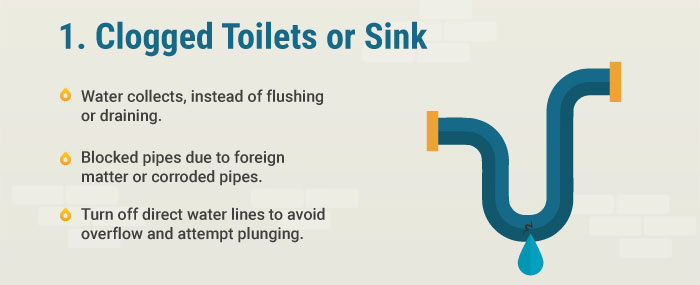
1. Clogged toilets or sink
If you have a clogged toilet or sink, the water will be collecting instead of flushing or draining. The primary causes of clogged toilets and sinks are the pipes getting blocked by foreign material or corrosion.
Foreign material – how it blocks your toilet pipes
When it comes to toilets, foreign material includes anything other than human waste and toilet paper. In case you are unsure what can and cannot be flushed down the toilet, we have created a list of things not to flush down the toilet.
- Underwear, socks and any other item of clothing.
- Sanitary products.
- Cotton buds (little ear cleaning sticks) and cotton pads (primarily used to remove make up).
- Dental floss.
- Anything plastic, including plastic bags.
- Diapers!
- ‘Flushable’ wipes of any description. Unfortunately, they are in fact NOT flushable.
Foreign material – how it blocks your kitchen sink
Kitchen sinks have very narrow pipes and a U-bend in the pipe (that loop of pipe that you can see underneath your sink), which makes them notorious for becoming clogged. To avoid blockages in your kitchen sink, here are some tips.
- Do not wash large chunks of food down the drain.
- Have a sink catcher, a type of plug that collects bits of food, and empty it into your kitchen bin frequently. Don’t just try and wash the food scraps down the drain.
- Run some hot water down your drain after doing the dishes, this will prevent fat and oil from building up in your pipes.
Corroded pipes – how this clogs your toilet and sink
A common type of corrosion that causes blockages in toilets and sinks is called scale. Scale is a mineral coating that builds up on the inside of pipes. It is caused by hard water (water with a high mineral content) being heated and transferred through pipes. If you have hard water, the only way to avoid scale is to have your water tested and follow correct water softening techniques. If you find scale in your pipes, it is best to call a qualified plumber.
How to fix clogged toilets and sinks
- Turn off direct water lines in order to avoid overflow. Don’t turn on the kitchen sink taps and do not flush the toilet.
- Attempt plunging. Please note that plunging a toilet is much easier than plunging a sink, so if you sink is not draining it may be best to call a plumber straight away. Also, if simple plunging does not unclog your toilet, you should contact a plumber.
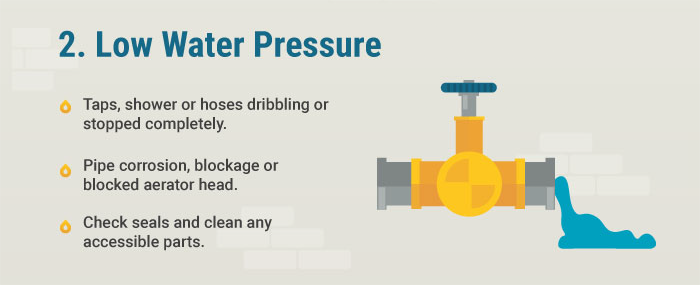
2. Low water pressure
If you have low water pressure, your taps, showers or hoses will be dribbling or may have stopped completely.
Causes of low water pressure
- Pipe corrosion. As mentioned before, scale can gradually build up to the point where there is a very restricted flow of water coming through the pipe.
- Blockage. Foreign material in your pipes may have led to a blockage.
- Blocked aerator head. Aerator heads are found on the end of most bathroom and kitchen faucets. They are screwed on and their purpose is to add an even amount of air to the water as it comes out of the tap. Aerator heads can get blocked by mineral deposits, similar to pipes and scale.
How to fix low water pressure
- Check seals. Make sure taps and hoses are all properly sealed and not leaking at any points.
- Clean any assessable parts, including the blocked aerator head. Clearing a blocked aerator head is an achievable home repair job. If you would like to have a go at fixing your blocked aerator head, we suggest reading this article – it gives a comprehensive breakdown on how to successfully do it.
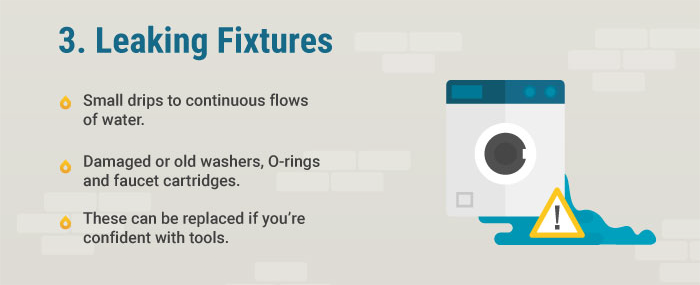
3. Leaking fixtures
Leaks are classified as anything from a small drip to a continuous flow of water coming from your turned off fixture.
Causes of leaking fixtures
- Damaged or old tap parts, including washers, O-rings or faucet cartridges. A washer is a thin disk-shaped plate with a hole in the middle, which is made of either metal or plastic and is used in conjunction with screws or nuts. O-rings are used in plumbing to prevent fluid or gases from going in or out of a designated area. A faucet cartridge is a special type of faucet that doesn’t require a washer and is commonly used in the kitchen and bathroom.
How to fix leaking fixtures
The old or damaged parts simply need to be replaced. If you have the right tools and are confident, you can do this yourself. Here are some clear instructions for fixing a leaking faucet cartridge.
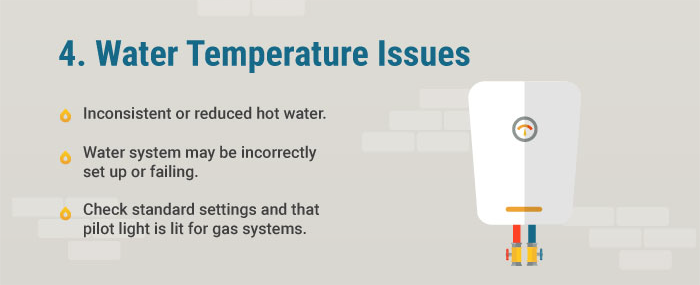
4. Water temperature issues
Water temperature issues can be characterised in a couple of different ways. We consider it an issue if the water temperature is inconsistent, changes erratically or if there is reduced hot water.
Causes of water temperature issues
- Incorrectly set up water system.
- A water system that is failing.
How to fix water temperature issues
If you have checked your standard settings and cannot see an issue, then call a plumber. Also, if you have a gas system, simply check that the pilot light is lit. If it is lit and you are still experiencing issues, call a trusted plumber.
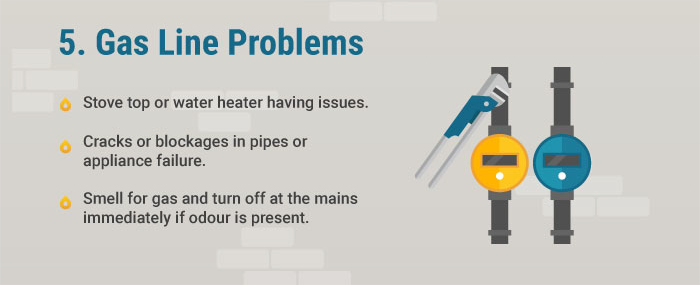
5. Gas line problems
If your gas stove top or gas water heater are experiencing issues, then you may have a problem with your gas line.
Causes of gas line problems
- Cracks or blockages in the pipes.
- Appliance failure.
How to fix gas line problems
Gas line problems can be very serious; gas leaks can kill people if they go undetected. Smell of gas and turn off the tap at the mains immediately if an odour is present. Then call a professional – it is not something you can fix by yourself.
If you have tried our suggested solutions to resolve your plumbing issue, and you’re still having trouble, know when to get help.
Call us on 0422 146 177 and speak directly to a plumber. We’ll be pleased to offer you straightforward advice and a free quote.
